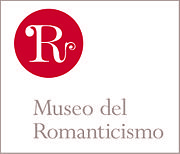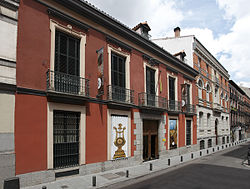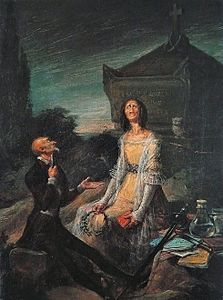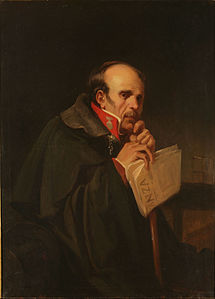Museum of Romanticism (Madrid)
Museo del Romanticismo | |
 | |
 Main façade of the Museum | |
 | |
Former name | Museo Romántico |
|---|---|
| Established | 1 June 1924 |
| Location | Calle de San Mateo 13, Madrid, Spain |
| Coordinates | 40°25′33.128″N 3°41′55.820″W / 40.42586889°N 3.69883889°W |
| Type | Art museum |
| Official name | Museo del Romanticismo |
| Type | Non-movable |
| Criteria | Monument |
| Designated | 1962 |
| Reference no. | RI-51-0001381 |
The Museum of Romanticism (Spanish: Museo del Romanticismo) is an art museum in Madrid, Spain, devoted to Romanticism. It was inaugurated in 1924 as Museo Romántico. It is one of the National Museums of Spain and it is attached to the Ministry of Culture.
History
[edit]
The museum is housed at Calle de San Mateo 13.[1] It was linked since its inception to the patronage of the Marquis of Vega-Inclán.[2] The museum opened on 1 June 1924.[3] The building was purchased by the Spanish State three years after the inauguration of the museum, in 1927.[3] The overseeing institution and the entire collection of the Marquis was bequeathed to the Spanish State after the death of the former in 1942.[2][3]
The building, dating from the late 18th-century, consists of two stories plus an attic floor, which is not open to the public.
Both the collection and the building were protected as historical-artistic monument in 1962.[3]
The museum's exhibits are presented in the context of a historic house with a dining room, billiard room etc. They include items related to the romantic writer Mariano José de Larra.
In November 2009, the Council of Ministers determined the renaming of the museum to Museo Nacional del Romanticismo.[3]
Collection
[edit]Some of the landmark items exhibited at the museum include painting works by Francisco de Goya (San Gregorio Magno), Leonardo Alenza (Satira del suicidio romántico, Sátira del suicidio por amor and El dios grande), Valeriano Domínguez Bécquer (El conspirador carlista), Antonio Carnicero (Retrato de Godoy), José Aparicio (Desembarco de Fernando VII), Joaquín Espalter (La familia Flaquer), Vicente López Portaña (Retrato del Marqués de Remisa), Antonio María Esquivel (El general Prim a caballo and Retrato de Alfredito Romea), Eugenio Lucas Velázquez (Cueva de bandidos), Charles Porion (Isabel II pasando revista a las tropas), Federico de Madrazo y Kuntz (Retrato del Duque de Rivas, Retrato de la Duquesa de Rivas, and Retrato de Julián Romea), José de Madrazo (Retrato de Fernando VII a caballo), Jenaro Pérez Villaamil (Puerta de Serranos en Valencia), Joaquín Sorolla (Retrato del Marqués de la Vega-Inclán), Manuel Cabral Bejarano (La copla), José Gutiérrez de la Vega (Retrato de Isabel II and Retrato de Larra) and Francisco de Zurbarán (San Francisco).[4]
Gallery paintings
[edit]-
Francisco de Goya, San Gregorio Magno
-
Leonardo Alenza, Sátira del suicidio romántico
-
Leonardo Alenza, Sátira del suicido por amor
-
Leonardo Alenza, El dios grande
-
Valeriano Domínguez Bécquer, The carlist conspirator
-
Manuel Cabral Bejarano, La copla
Museum galleries
[edit]References
[edit]- Citations
- ^ Donoso Guerrero 1989, p. 3.
- ^ a b Torres González 1998, p. 64.
- ^ a b c d e García Ramos 2013, p. 149.
- ^ Torres González 1998, pp. 73–74.
- Bibliography
- Donoso Guerrero, Rosa (1989). "El Museo Romántico" (PDF). Villa de Madrid. 27 (99). Madrid: Ayuntamiento de Madrid: 3–24. ISSN 0042-6164.
- García Ramos, María Dolores (2013). "Museo Nacional del Romanticismo". Casas Museo de recreación de ambientes. Una aproximación al caso español. Córdoba: UNED. pp. 145–164. ISBN 978-84-88115-22-5.
- Torres González, Begoña (1998). "El Museo Romántico: Un museo de ambiente". Revista Museo Romántico (1). Madrid: Ministerio de Educación y Cultura: 64. ISSN 1579-3761.
External links
[edit]- Official website
- Museum of Romanticism (Madrid) within Google Arts & Culture
 Media related to Museo del Romanticismo de Madrid at Wikimedia Commons
Media related to Museo del Romanticismo de Madrid at Wikimedia Commons
















